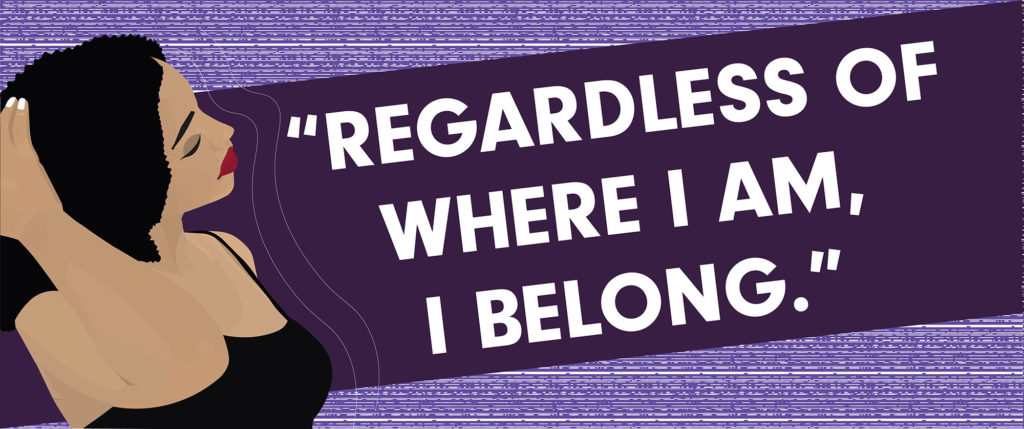
Ashley DeLeon | Executive Editor | adeleon@mail.smcvt.edu
I arrived a few minutes before the first day of an English course two years ago and sat within the rectangular arrangement of chairs and desks. As peers streamed into the classroom from a crowded hallway on the second floor of St. Edmund’s, I noticed several empty chairs that separated me from my peers. More students trickled into the classroom, and every seat they sat in was far from me but close to each other. It wasn’t until the seats filled up that people would sit next to me.
To ease my anxious self before class began, I scrolled through Instagram to distract myself. However, every few seconds I felt like I was being observed. I would look up, and peers would quickly break eye contact.
I felt out of place, like I didn’t belong. With a few minutes left before class began, I then reflected on an anecdote my father shared a few months before I started college.
On his first day of undergraduate study at Rutgers University in 1988, my father was the only Black person in a lecture hall of 300 students. He recalled walking into the classroom and being taken aback.
“Yes, you’re the only Black person in here. Get used to it,” he recollected his professor saying to him.
After class, the professor pulled my father aside and told him not to second guess his sense of belonging.
“He said this is something I would face all throughout college, and I just had to adapt,” my father said.
Like my father, I am the only Black person in many of my classes. Adaptation is hard.
How do I adapt to microaggressions and uncertainties in a classroom, like when my professor used a racial slur in class? Or when a classmate looks at me and says they don’t see color?
When incidents like this happened, adaptation seemed absurd. However, my father said I would eventually adapt and learn to navigate.
This past summer, I worked at VTDigger as a general assignment intern, and I was the only Black person in the newsroom. Thankfully, the staff editors and writers were very supportive and understood the importance of representation in newsrooms. They supported my advocacy for pitching stories that highlighted overlooked stories from the BIPOC community. However, it took at least a month for me to adjust to being the “only one.”
I pitched stories that highlighted underrepresented communities, and even attended a protest about a man who was racially discriminated against by police. He spoke with me and expressed how comfortable he felt to share his story with me, a Black reporter. Being a Black reporter in a predominantly white state meant that people could feel comfortable sharing their stories with me.
Unfortunately, one thing I nor my father could prepare me for was microaggressions and racially motivated judgments from readers.
A reader once told me to get a haircut. I chuckled.
Someone called me a white liberal. To this day, I laugh in utter confusion.
A reader called me ignorant over social media. I cried profusely. At that moment, I truly felt what it was like to be the only one. Unlike microaggressions in classrooms, instances like these were public. I felt humiliated and didn’t know who to turn to.
For a long time, I had never met a full-time reporter of color. Last week, I met a notable reporter of color who passed along wisdom and guidance.
I met Anne Wallace Allen from Seven Days VT at the Montpelier statehouse last Tuesday. My friend and I interviewed her for a documentary film about newsroom diversity in Vermont and the efforts of media stakeholders to diversify these spaces.
As she walked toward us, I beamed with excitement. Allen is a well-known journalist in Vermont, and has vast experience being the only one of color in spaces.
She and I spoke before and after the interview, and I felt a sense of comfort as if I just returned home from a long break away from family.
We discussed the importance of representation in the newsroom. We swapped stories of hurtful judgments and statements we experienced over time.
She shared that a co-worker was surprised to find that she was born in another country and had a green card at one point. Her peer then said, “don’t worry, we’ll let you stay here.”
Hearing Anne share her experiences made me feel understood. She instilled in me that being the only person of color in spaces is inevitable.
Anne also taught me to own the space I occupy and never feel as if I’m “less than.”
Everyone has a mentor who they can look up to. In my life, I have many who guide me in the right direction and support me unconditionally.
Now, I can walk into a space as the only person of color and feel a sense of empowerment. Regardless of where I am, I belong.
My father was right. I did find my way, and now I can bring my refurbished sense of empowerment with me wherever I go.

